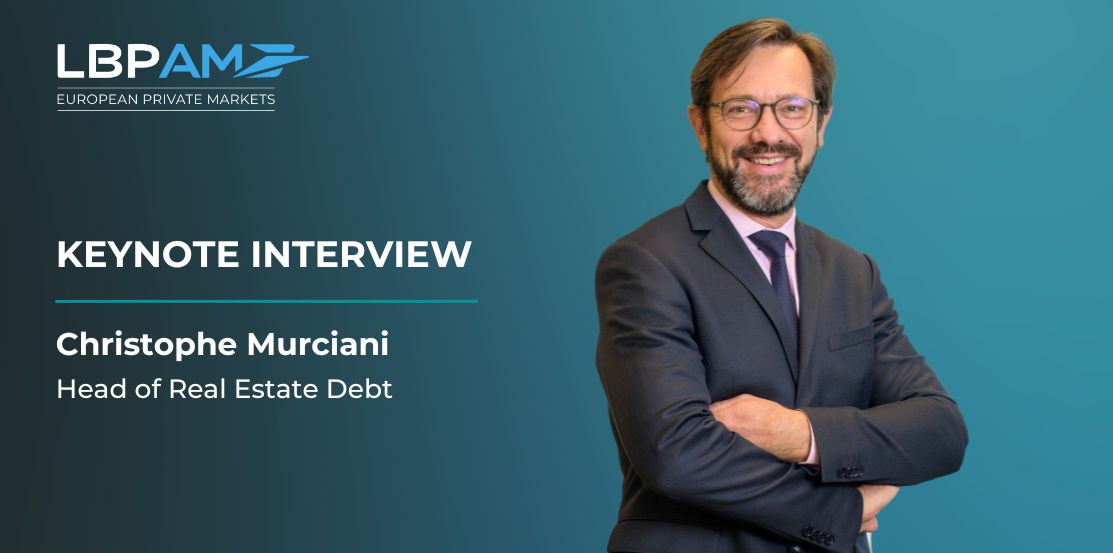Investors are recognising real estate debt’s merits
03.06.2025|13 min

In a market searching for yield and stability, Christophe Murciani of LBP AM European Private Markets sees mid-market real estate debt as a sweet spot offering equity-like returns with less volatility.
Over the past 12 years, LBP AM European Private Markets has deployed approximately €2.8 billion across 75 property loans spanning a broad mix of asset classes across Europe. With a strong forward focus on the mid-market, Christophe Murciani, head of real estate debt, outlines the key advantages this area can offer investors seeking diversification and stable, equity-like – or even above-equity – returns.
What key market conditions need to shift before we see a meaningful rebound in real estate investment activity and a more active deployment of real estate debt?
The main thing that needs to change is that we still haven’t recovered the historic risk premium. Government bond yields remain elevated. Everyone talks about monetary policy easing and how this will support the real estate market, but that only impacts leveraged buyers – those whose funding costs improve and can acquire more value-add or repositioning assets. But that’s only one side of the market. Core properties – most of the transaction volume – is office driven. Such large assets do not seem likely to trade soon without lender pressure to sell. And with high government bond yields and presum- ably some value declines, there’s little incentive for institutional investors to rotate portfolios. Trading volumes are down because large office transactions have disappeared since 2022.
So, either government bond yields need to come down or property cap rates need to expand – there’s still some adjustment needed in property prices. The best assets in Paris trade at circa 4 percent, while government bonds are hovering around 3.20-3.50 percent. This is a 50-75 basis points premium, which means there is not much more adjustment needed to return to the historic norm of 100-120 basis points. When the property premium over government bonds normalises, we are likely to see more portfolio churn and larger office deals. That’s probably to- wards year-end, assuming bond yields don’t spike again due to trade tensions.
How critical is resolving the gap between appraised values and market realities to unlocking deal flow and facilitating debt deployment?
That’s the crux of the matter. Valuations haven’t fully adjusted yet: landlords pressure valuers and banks re-sist big markdowns to avoid covenant breaches and provisioning. So, the process is slow. In 2022, [French] bond yields jumped from negative to 2.8 percent, yet valuations only dropped 2 percent; a clear disconnect there and then. Given that some catching up has already taken place, the remaining gap is no longer dramatic.
Public REIT s in Europe made the valuation gap more visible by trading at discounts to NAV , but the private market – larger and more active – has been slower to adjust, especially in France and Germany. The UK corrected more quickly and Italy, with its strong foreign investor base, tends to adjust fast-er, too.
But as long as that gap isn’t breached, then I think it really is a matter of government bonds stabilising and the risk premium returning to normal. If government bonds stay where they are, you need the cap rates to expand a mere 25 basis points for prime assets, meaning we have already covered a lot of ground.
There starts to be anecdotal evidence of leveraged owners facing loan maturities with no refinancing options being forced to sell. In those instances, banks are losing up to 50 percent of the loan balances for assets in oversupplied peripheral office markets, which lack alternative uses unless there’s patient capital willing to wait for municipal planning consent over 10 years or more. That doesn’t suit value-add or opportunistic investors. So, the walls are starting to crack in a few specific spots.
The expectation for me is that there will be more distress, probably not in large institutional-grade assets, but in smaller peripheral offices. We could see 40–60 percent principal losses, meaning equity is wiped out.
In what ways does private real estate debt offer a compelling alternative to equity for institutional investors in the current environment?
In the current market, there’s equity volatility, something that doesn’t feature in private debt. We offer downside protection because there’s equity sitting on top of our debt exposure, so our mark-to-market is pretty stable over time.
Right now, we have a clear accretive return. Private real estate debt yields around 5 percent on a swap basis, compared to 4.25 percent for holding a prime Paris office directly. In this case, senior secured debt yields more than prime offices, offering a better risk-return profile, as you also have the equity cushion from the borrower.
We also provide regular distributions via quarterly coupons and our borrowers have to repay at a given date. So, we provide liquidity at maturity, which is very different from private equity. Of course, listed equity offers daily liquidity, but then you have that volatility exposure. What we offer is a trade-off; you give up liquidity in exchange for no volatility on your books. And that translates into a premium – about 100-120 basis points above the listed market for equivalent risk.
How does private real estate debt enhance diversification in institutional portfolios – both geographically and across property sectors?
Geographically, private debt offers the same diversification benefits as investing with a private equity fund operating across multiple jurisdictions and sectors. It’s delegated management and deployment, allowing you to access various countries and cover many asset classes.
We focus on certain assets across regions. In Spain, we look at logistics and office more than residential and student housing, as those have become very hot and liquid in the banking market, so it’s not where we believe we can generate the best returns. In France, we target speculative logistics development. That’s an area where banking liquidity is drying up, and we see potential to create value for our investors. As I mentioned, mid-market office renovations in major European city centres are also a clear focus for us.
In Italy, we’re interested in shopping centres in mid-size cities, as well as logistics in the north. And in the Netherlands, we really like mixed portfolios – it’s a market where local banks typically won’t go below €100 million.
Such may be our current focal points, but as the property market shifts, so will our investment profile. We have been rebalancing our exposures away from larger office assets as early as 2019, adding hotel, industrial, retail portfolio in our mix.
Are institutional investors approaching private real estate debt from their real estate allocation or as a part of their private debt strategy?
Institutional investors still tend to view real estate debt as part of their real estate allocation. Because many are already at their target allocations for real estate, they find it difficult to add a layer of real estate debt. On the other hand, most don’t put it in the fixed income bucket, where the relative value is more pronounced. If that perception shifts, it could create an influx of liquidity into the private real estate debt market. We’re not there yet, but perhaps in one or two years that change will happen.
Do investors view the asset class more as a longterm strategic allocation or as a cyclical opportunity tied to market dislocation?
We’re already seeing a growing number of inbound inquiries. Some institutions are even reverse inquiring. I think investors are starting to recognise the merits of real estate debt. It offers valuation stability, income stability, liquidity and an accretive return.
As we see it, investors will simply turn the dial up or down on real estate debt depending on where the public markets are. When the public markets offer 300 basis points over Euribor for a triple-B bond that you can trade day in, day out, they’ll probably tune down on private debt and move back to public markets.
Still, because funds are not structured overnight, investors will maintain a regular dialogue with fund managers and stay invested in funds over the long run – maybe not in huge individual tickets, but as a mainstream revenue stream with no volatility, regular distributions and timely exits – because borrowers have to repay at a certain date. We think that will become part of the basic revenue stream for institutional investors
What role are private lenders playing to help mid-market borrowers finance ESG upgrades and support the long-term sustainability of the real estate stock?
